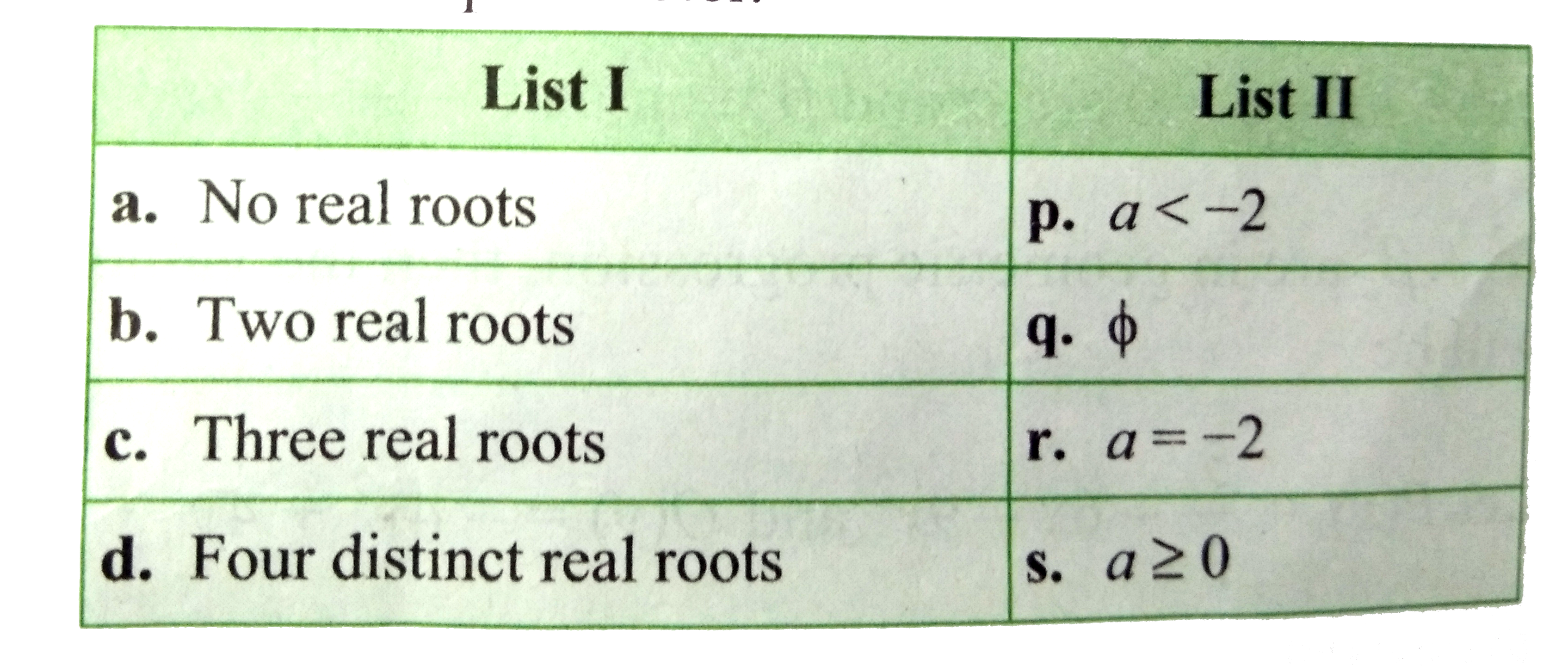Consider the equation x4+2ax3+x2+2ax+1=0 where a∈R. Also range of function f(x)=x+1x is (−∞,−2]∪[2,∞) If equation has at least two distinct positive real roots then all possible values of a are Solution in Bengali
2
1
0
3
The correct Answer is:3
If exctly two roots are positive, the other two roots are negative. The -2 and 2 must lie between the roots. So,
f(−2)<0andf(2)<0
⇒a>3/4anda><−3/4
Hence, no such values of a exist.
Topper's Solved these Questions
- BOOK - CENGAGE PUBLICATIONCHAPTER - THEORY OF EQUATIONSEXERCISE - MATRIX MATCH TYPE6videos
THEORY OF EQUATIONS
- BOOK - CENGAGE PUBLICATIONCHAPTER - THEORY OF EQUATIONSEXERCISE - NUMERICAL VALUE TYPE43videos
THEORY OF EQUATIONS
- BOOK - CENGAGE PUBLICATIONCHAPTER - THEORY OF EQUATIONSEXERCISE - Multiple Correct Answer Type38videos
THEORY OF EQUATIONS
- BOOK - CENGAGE PUBLICATIONCHAPTER - STRAIGHT LINESEXERCISE - ARCHIVES (NUMERICAL VALUE TYPE)1videos
STRAIGHT LINES
- BOOK - CENGAGE PUBLICATIONCHAPTER - THREE DIMENSIONAL GEOMETRYEXERCISE - All Questions291videos
THREE DIMENSIONAL GEOMETRY
Similar Questions
Match the following for the equation x2+a|x|+1=0 where, a is a parameter.
 08:07View Solution
08:07View SolutionIf x=2+22/3+21/3 , then the value of x3−6x2+6x is
02:58View SolutionIf c≠0 and the equation p2x=ax+c+bx−c has two equal roots, then p can be
03:45View SolutionFor a point P in the plane, let d1(P)andd2(P) be the distances of the point P from the lines x−y=0andx+y=0 respectively. The area of the region R consisting of all points P lying in the first quadrant of the plane and satisfying 2≤d1(P)+d2(P)≤4, is
06:29View SolutionFind the angle between the line whose direction cosines are given by l+m+n=0andl2+m2−n2=0.
04:00View SolutionComplete set of real values of 'a' for which the equation x^(4)-2ax^(2)+x+a^(2)-a=0 has all its roots real
04:17View Solutionf ={(x,x^2/(x^2+1)): x in R} ,be a function R into R,range of 'f' 1)[0,1) 2) (-oo,oo) 3) (0,oo) 4) R^+
05:52View SolutionComplete set of real values of 'a' for which the equation x^(4)-2ax^(2)+x+a^(2)-a=0 has all its roots real:
08:51View SolutionThe possible values of a such that the equation x2+2ax+a=√a2+x−116−116,x≥−a, has two distinct real roots are given by: [0,1] (b) [−∞,0] [0,∞] (d) (34,∞)
View SolutionIf the root of the equation (a−1)(x2−x+1)2=(a+1)(x4+x2+1) are real and distinct, then the value of a∈ a.(−∞,3] b. (−∞,−2)∪(2,∞) c. [−2,2] d. [−3,∞)
04:09View SolutionIf the equation (x1+x2)2+a(x1+x2)+3=0 has exactly two real roots which are distinct, then the set of possible real values of a is (−132,0) (b) (∞,−132) (−132,132) (d) (132,∞)
04:21View SolutionConsider the equation x^(4)+2ax^(3)+x^(2)+2ax+1=0 where a in R Also range of function f(x)=x+(1)/(x) is (-oo,-2]uu[2,oo) If equation has at least two distinct positive real roots then all possible values of a are
03:28View SolutionFor what values of the parameter a the equation x4+2ax3+x2+2ax+1=0 has atleast two distinct negative roots?
06:20View SolutionThe equation x4+2ax3+x3+2ax+1=0 has at least two distinct negative roots is
09:55View SolutionIf the equation x2+2ax+b(a−1)=0 has real roots for all real value of a and b is an integer, then
06:36View SolutionIf the root of the equation (a−1)(x2−x+1)2=(a+1)(x4+x2+1) are real and distinct, then the value of a∈ a.(−∞,3] b. (−∞,−2)∪(2,∞) c. [−2,2] d. [−3,∞)
04:36View Solution

